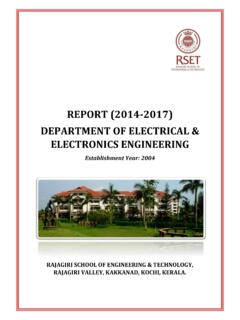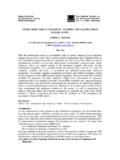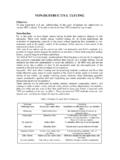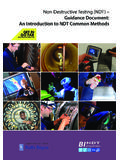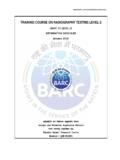Transcription of Radiography Testing - Rajagiri School of Engineering ...
1 Module 5 - Radiography Testing Radiography Radiography is used in a very wide range of applications including medicine, Engineering , forensics, security, etc. In NDT, Radiography is one of the most important and widely used methods. Radiographic Testing (RT) offers a number of advantages over other NDT methods, however, one of its major disadvantages is the health risk associated with the radiation. Asst. Prof. Vishnu Sankar,DME,RSET RT is one of the most widely used NDT methods for the detection of internal defects such as porosity and voids. With proper orientation of the X-ray beam, planar defects can also be detected with Radiography . It is also suitable for detecting changes in material composition, thickness measurements and locating unwanted or defective components hidden from view in an assembled part.
2 Asst. Prof. Vishnu Sankar,DME,RSET In general, RT is method of inspecting materials for hidden flaws by using the ability of short wavelength electromagnetic radiation (high energy photons) to penetrate various materials. The intensity of the radiation that penetrates and passes through the material is either captured by a radiation sensitive film (Film Radiography ) or by a planer array of radiation sensitive sensors (Real-time Radiography ). Film Radiography is the oldest approach, yet it is still the most widely used in NDT. Asst. Prof. Vishnu Sankar,DME,RSET Basic Principles In radiographic Testing , the part to be inspected is placed between the radiation source and a piece of radiation sensitive film. The radiation source can either be an X-ray machine or a radioactive source.
3 The part will stop some of the radiation where thicker and more dense areas will stop more of the radiation. The radiation that passes through the part will expose the film and forms a shadowgraph of the part. The film darkness (density) will vary with the amount of radiation reaching the film through the test object, where darker areas indicate more exposure (higher radiation intensity) and lighter areas indicate less exposure (higher radiation intensity). Asst. Prof. Vishnu Sankar,DME,RSET The variation in the image darkness can be used to determine thickness or composition of material and would also reveal the presence of any flaws or discontinuities inside the material. Asst. Prof. Vishnu Sankar,DME,RSET Advantages of RT Both surface and internal discontinuities can be detected.
4 Significant variations in composition can be detected. It can be used on a variety of materials. Can be used for inspecting hidden areas (direct access to surface is not required) Very minimal or no part preparation is required. Permanent test record is obtained. Good portability especially for gamma-ray sources. Asst. Prof. Vishnu Sankar,DME,RSET Disadvantages Hazardous to operators and other nearby personnel. High degree of skill and experience is required for exposure and interpretation. The equipment is relatively expensive (especially for x-ray sources). The process is generally slow. Highly directional (sensitive to flaw orientation). Depth of discontinuity is not indicated. It requires a two-sided access to the component.
5 Asst. Prof. Vishnu Sankar,DME,RSET PHYSICS OF RADIATION Nature of Penetrating Radiation Both X-rays and gamma rays are electromagnetic waves and on the electromagnetic spectrum they occupy frequency ranges that are higher than ultraviolet radiation. In terms of frequency, gamma rays generally have higher frequencies than X-rays. The major distinction between X-rays and gamma rays is the origin where X-rays are usually artificially produced using an X-ray generator and gamma radiation is the product of radioactive materials. Both X-rays and gamma rays are waveforms, as are light rays, microwaves, and radio waves. X-rays and gamma rays cannot be seen, felt, or heard. They possess no charge and no mass and, therefore, are not influenced by electrical and magnetic fields and will generally travel in straight lines.
6 However, they can be diffracted (bent) in a manner similar to light. Asst. Prof. Vishnu Sankar,DME,RSET Asst. Prof. Vishnu Sankar,DME,RSET Electromagentic radiation act somewhat like a particle at times in that they occur as small packets of energy and are referred to as photons . Each photon contains a certain amount (or bundle) of energy, and all electromagnetic radiation consists of these photons. The only difference between the various types of electromagnetic radiation is the amount of energy found in the photons. Due to the short wavelength of X-rays and gamma rays, they have more energy to pass through matter than do the other forms of energy in the electromagnetic spectrum. As they pass through matter, they are scattered and absorbed and the degree of penetration depends on the kind of matter and the energy of the rays.
7 Asst. Prof. Vishnu Sankar,DME,RSET Properties of X-Rays and Gamma Rays They are not detected by human senses (cannot be seen, heard, felt, etc.). They travel in straight lines at the speed of light. Their paths cannot be changed by electrical or magnetic fields. They can be diffracted, refracted to a small degree at interfaces between two different materials, and in some cases be reflected. Their degree of penetration depends on their energy and the matter they are traveling through. They have enough energy to ionize matter and can damage or destroy living cells. Asst. Prof. Vishnu Sankar,DME,RSET Electromagnetic Radiation sources X ray source In the widely used conventional X Radiography , the source of radiation is an X-ray tube.
8 It consists of a glass tube under vacuum, enclosing a positive electrode or anode and a negative electrode or cathode . The cathode comprises a filament, which when brought to incandescence by a current of a few amperes, emits electrons. Under the effect of electrical tension set up between the anode and the cathode, these electrons are attracted to the anode. Asst. Prof. Vishnu Sankar,DME,RSET Asst. Prof. Vishnu Sankar,DME,RSET The stream of electrons is concentrated in a beam by a cylinder or a focusing cup. The anti-cathode is a slip of metal with high melting point recessed in to the anode, where it is struck by the beam of electrons. It is by impinging on the anti-cathode that fast moving electrons give rise to X-rays. Asst.
9 Prof. Vishnu Sankar,DME,RSET The development of electronics has led to the availability of constant potential units which give stable operating conditions. The replacement of glass tubes by metal ceramic ones has led to an extended tube life. X-ray machines are characterized by the operating voltage and current which determine the penetrability and intensity of radiation produced. Modern X-ray generators are available up to 450 kV and 50 mA. Highly automated self propelled X-ray mini-crawlers which travel within pipelines are used to take radiographs of pipelines and welds from inside. Asst. Prof. Vishnu Sankar,DME,RSET The area of the anti-cathode which is struck by the electron flux is called the focal spot or TARGET. It is essential that this area should be sufficiently large, in order to avoid local heating which may damage the anti-cathode and to allow rapid dissipation of heat.
10 The projection of the focal spot on a surface perpendicular to the axis of the beam of X-rays is termed as the optical focus or focus . This focus has to be as small as possible in order to achieve maximum sharpness in the radiographic image. Asst. Prof. Vishnu Sankar,DME,RSET Production of X-rays X-rays are produced when fast moving electrons are suddenly brought to rest by colliding with matter. Electrons may also lose energy by ionization and excitation of the target atoms. The accelerated electrons lose their kinetic energy (KE) very rapidly at the surface of the metal plate, and energy conversion occurs. Asst. Prof. Vishnu Sankar,DME,RSET Conversion in 3 different ways: 1. A very small fraction (< 1 %) is converted into X radiation.





